Colombia << kuh LUHM bee uh or koh LOHM bee ah >> is a country in northwestern South America. It is the only country on the continent with a coast along both the Atlantic Ocean and the Pacific Ocean. Colombia ranks second in population and fourth in area among the countries of South America. Only Brazil has more people, and only Brazil, Argentina, and Peru cover a larger area.
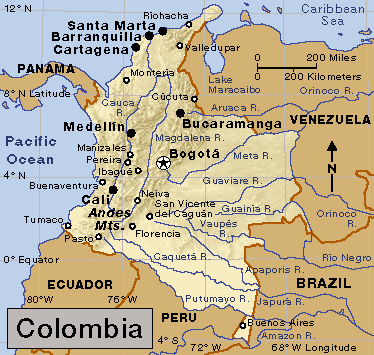
Colombia’s landscape and climate offer striking contrasts, ranging from the snow-capped peaks of the Andes Mountains to hot lowland plains. The equator crosses southern Colombia. Yet parts of the country have a chilly climate because of their high elevation.
The population of Colombia is distributed unevenly. Most of the people live in valleys and basins of the Andes Mountains. Bogotá, Colombia’s capital and largest city, lies in a basin of the Andes.
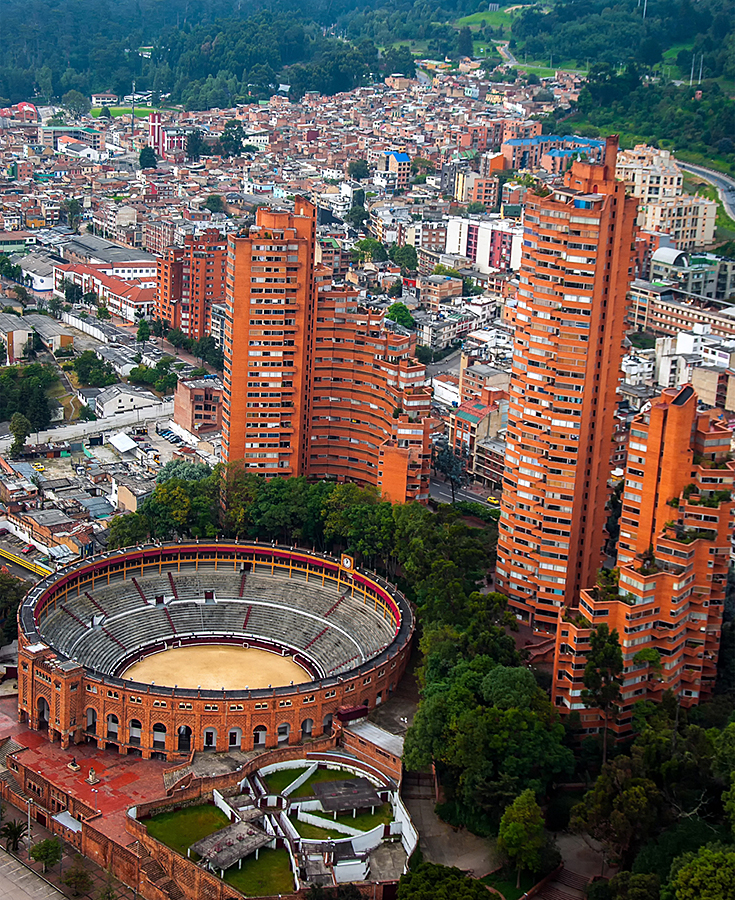
The differences in climate throughout Colombia enable farmers to grow many kinds of crops, including bananas, coffee, flowers, potatoes, and rice. Colombia is one of the world’s leading coffee-producing countries.
Colombia’s economy has traditionally depended on agriculture. However, the economy has become much more diverse since the mid-1900’s. The country has a strong manufacturing industry, huge supplies of raw materials, and enormous sources of energy, including oil. The export of oil provides an important source of revenue. But Colombia has not fully developed its vast resources.
During the early 1500’s, Colombia’s natural wealth, especially its gold, attracted Spanish explorers. The Spaniards conquered most of the Indigenous people, the region’s original inhabitants. Colombia remained a Spanish colony for nearly 300 years, but it was never one of Spain’s most important colonies. After the colonial provinces began to declare independence in 1810, the region suffered long periods of violence and civil war. But unlike some other Latin American countries, Colombia has a tradition of democratic government.
Colombia was named after the Italian navigator Christopher Columbus. The nation’s official name is República de Colombia (Republic of Colombia).
Government
Colombia is a republic. The country’s most recent constitution was adopted in 1991. All citizens 18 years of age and older may vote.
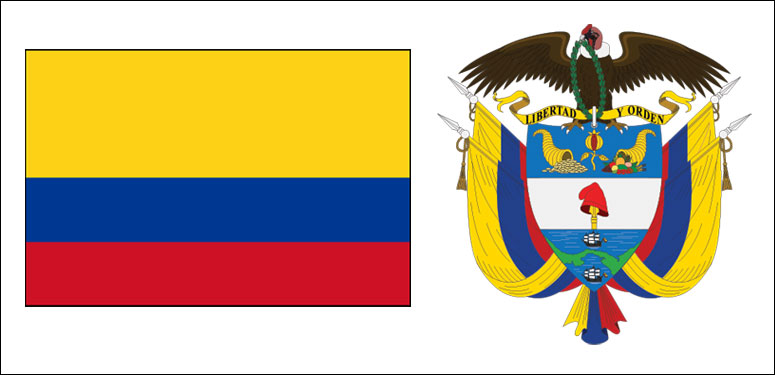
National government.
A president, elected by the people to a four-year term, heads Colombia’s government. The vice president also is elected by the people for one four-year term. The vice president takes over the presidency upon the death, illness, or resignation of the president. Congress, the nation’s legislature, consists of the Senate and the House of Representatives. Voters elect senators and representatives to four-year terms.
Local government.
Colombia is divided into 32 departments and the Capital District, which consists of Bogotá. Each department has a governor and an assembly, and a mayor and city council govern the Capital District. These local officials are all elected by the people.
Politics.
Two parties, the Colombian Conservative Party and the Colombian Liberal Party, have long dominated the country’s politics. Both parties follow moderate policies. In the early 2000’s, other parties began to gain significant representation in Congress. These parties include the Democratic Center party, the Green Alliance, the Radical Change Party, and the Social Party of National Unity.
Courts.
Colombia has four judicial bodies that are equal in rank. The Supreme Court of Justice is the highest court of criminal and civil law. The Council of State is the highest court of administrative law. The Constitutional Court is the highest court for constitutional matters and international treaties. The Superior Judicial Council administers the government’s judicial branch and disciplines judges.
Armed forces.
Colombia has an army, a navy, and an air force. All men 18 years old must register for the military draft.
People
Nearly all of Colombia’s people live in the western part of the country, mainly in valleys and basins of the Andes Mountains. Only about 2 percent of the people live in the hot lowlands of eastern Colombia.
The municipality of Bogotá has about 7 million people. A municipality may include rural areas as well as the urban center. Three other municipalities—Cali, Medellín, and Barranquilla—have more than a million people each. Rural Colombians, called campesinos, have poured into the nation’s large cities since the 1940’s in search of a better life and to escape violence related to political conflict and guerrilla and paramilitary groups. Many campesinos are poor and have little education. Because of the high rates of migration from the countryside, Colombia’s large cities have problems of poverty, unemployment, and slum housing. The major cities also suffer from high crime rates. In the early 2000’s, however, Bogotá and Medellín saw a dramatic reduction in crime.
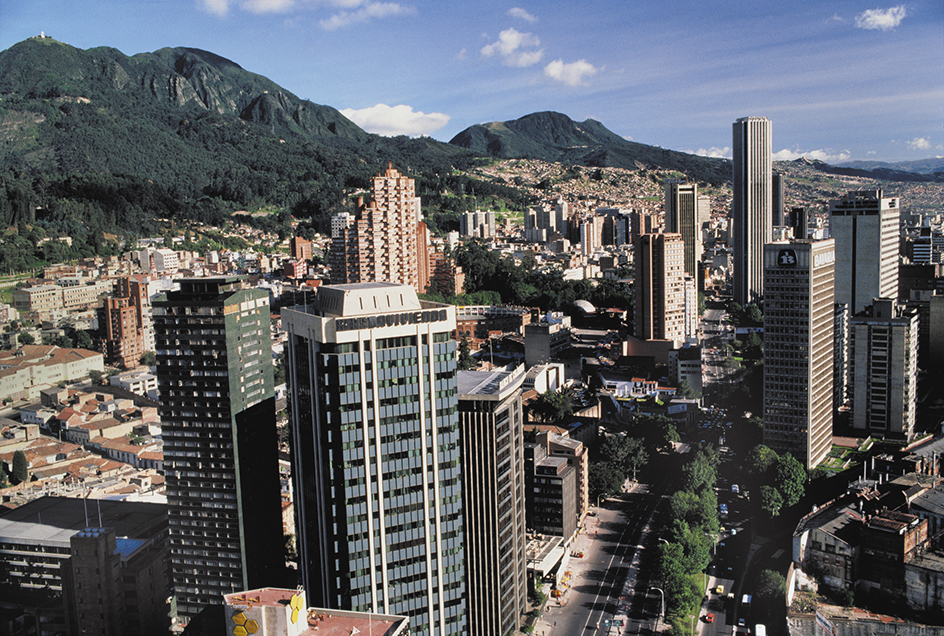
Ancestry.
Many Indigenous people lived in what is now Colombia when the first Spanish colonists arrived in the 1500’s. The Spaniards conquered the Indigenous people and later brought in Africans and enslaved them. Over the years, many Indigenous people, Spaniards, and Africans intermarried. Today, mestizos (people of mixed European and Indigenous ancestry) make up most of Colombia’s population. Afro-Colombians, people with African ancestry, make up at least 10 percent of the population. About 80 Indigenous groups make up 3 percent of the population. Indigenous people acquired significant cultural and political rights with the passage of the 1991 Constitution.
Language.
Nearly all Colombians speak Spanish, the country’s official language. Colombians closely guard their language to keep it from changing. They even passed a law to protect it from unnecessary change. Colombians consider their Spanish purer than that of other Latin American countries. More than 60 Indigenous groups still speak their traditional languages, but these groups make up a small percentage of Colombians.
Way of life.
In general, city dwellers in Colombia live better than country people. The cities have most of the nation’s schools, medical facilities, and cultural activities. The majority of middle- and upper-class Colombians live in cities. Upper-class families often have a nonworking farm in the countryside where they spend weekends.
In Colombia’s large cities, tall office and apartment buildings are replacing the traditional Spanish-style architecture. Spanish-style buildings are low, sprawling adobe structures with red tile roofs and patios.
Many rural Colombians build simple houses from locally available materials. In the warm, wet coastal regions, for example, they use bamboo poles and palm leaves to build well-ventilated houses. But in the cooler mountain zones, many houses have thick adobe walls.
For many years, Colombian families were large and held together by strong family ties. Women were mainly responsible for taking care of their families. But since the late 1900’s, families have become smaller, and now many women work outside the home.
In Colombia’s cities, the size of the middle class and the working class is growing as developing industries provide many new jobs. The middle class includes business people, government officials, and such professionals as doctors, lawyers, and engineers. Middle-class Colombians live in comfortable houses or apartments in attractive neighborhoods. Working-class people include salesclerks, factory and construction workers, and other Colombians with low-paying jobs. Many of them live in rundown buildings in older neighborhoods.
Crowded slumlike squatter settlements stand at the edges of Colombia’s large cities. They are called tugurios << too GOO ree ohs >> . Most tugurios have no running water, electric power, or sewers. Many newcomers from rural areas build shacks in the tugurios out of tin, cardboard, and other scrap materials. Some children in these areas run away or are abandoned by their parents, who cannot support them. These homeless children, called gamines << gah MEE nays >> , roam the streets and alleys. Most are boys. In the early 2000’s, the number fell dramatically due to improved access to social services.
Education.
Almost all of Colombia’s adults can read and write. Colombia’s Constitution requires children to attend one year of preschool and nine years of basic education. However, many rural children cannot meet this requirement because their schools do not offer enough grades. Colombia has many universities. The National University of Colombia is the largest university. Its main campus is in Bogotá.
Clothing.
Most of Colombia’s city dwellers dress much like people in North America and Europe. In chilly mountain areas, many Colombians wear woolen ruanas (blankets with a slit in the middle for the head).
Food and drink.
Different regions of Colombia have their own special dishes. In general, however, Colombians eat much starchy food, such as noodles, potatoes, and rice. They enjoy stews and thick soups. A favorite soup, called ajiaco << ah hee AH koh >> , contains cassava (a root crop), chicken, corn, and potatoes. Poor Colombians eat little meat, but fresh fruits and vegetables are abundant and inexpensive.
Both adults and children drink agua de panela << AH gwah day pah NEHL ah >> , a beverage consisting of brown sugar dissolved in water. Colombians also drink much of the beer produced in the country. Although Colombia is a leading coffee producer, most Colombians do not drink as much coffee as Americans and Europeans do.
Recreation.
Soccer is by far the most popular spectator sport in Colombia. Bullfights and auto races also draw large crowds. Swimmers and sunbathers enjoy the beaches along the Caribbean coast, and many cyclists enjoy the steep slopes of the Andes. Folk songs and dances preserve the traditional culture of the Indigenous people, Spanish colonists, and enslaved Africans. Loading the player...
Colombian folk music
Religion.
Nearly all Colombians are Roman Catholics, and many of them actively practice their religion. The Catholic Church has a close relationship with the government. However, Colombia’s Constitution guarantees freedom of worship. Since the late 1900’s, many Roman Catholics have joined evangelical Protestant churches.
The arts.
Such advanced Indigenous civilizations as the Chibcha and Muisca peoples created Colombia’s earliest works of art hundreds of years ago. Gigantic stone statues of Indigenous gods still stand high in the Andes Mountains in southern Colombia. Bogotá’s Gold Museum displays elegant jewelry, small figures, and other beautiful objects crafted by Indigenous goldsmiths.
Indigenous artistic traditions were gradually forgotten after Spanish colonists arrived in Colombia. Until the 1900’s, Colombia’s arts largely reflected European styles. During the mid-1900’s, several Colombian artists won international recognition for their original works. They include the painters Fernando Botero and Alejandro Obregon and the sculptor Edgar Negret.
Colombians greatly admire writers, especially poets. Many Colombian lawyers, teachers, and other professionals write poetry in their spare time. Maria (1867), a novel by Jorge Isaacs, became the first work of Colombian literature to win popularity throughout Latin America. The Colombian writer Gabriel García Márquez won the Nobel Prize in literature in 1982. A Colombian novelist and poet, Álvaro Mutis, won the Cervantes Prize, the highest award for literature written in Spanish, in 2001.
The land
Colombia covers 439,737 square miles (1,138,914 square kilometers). It can be divided into three mainland regions: (1) the Coastal Lowlands, (2) the Andes Mountains, and (3) the Eastern Plains.
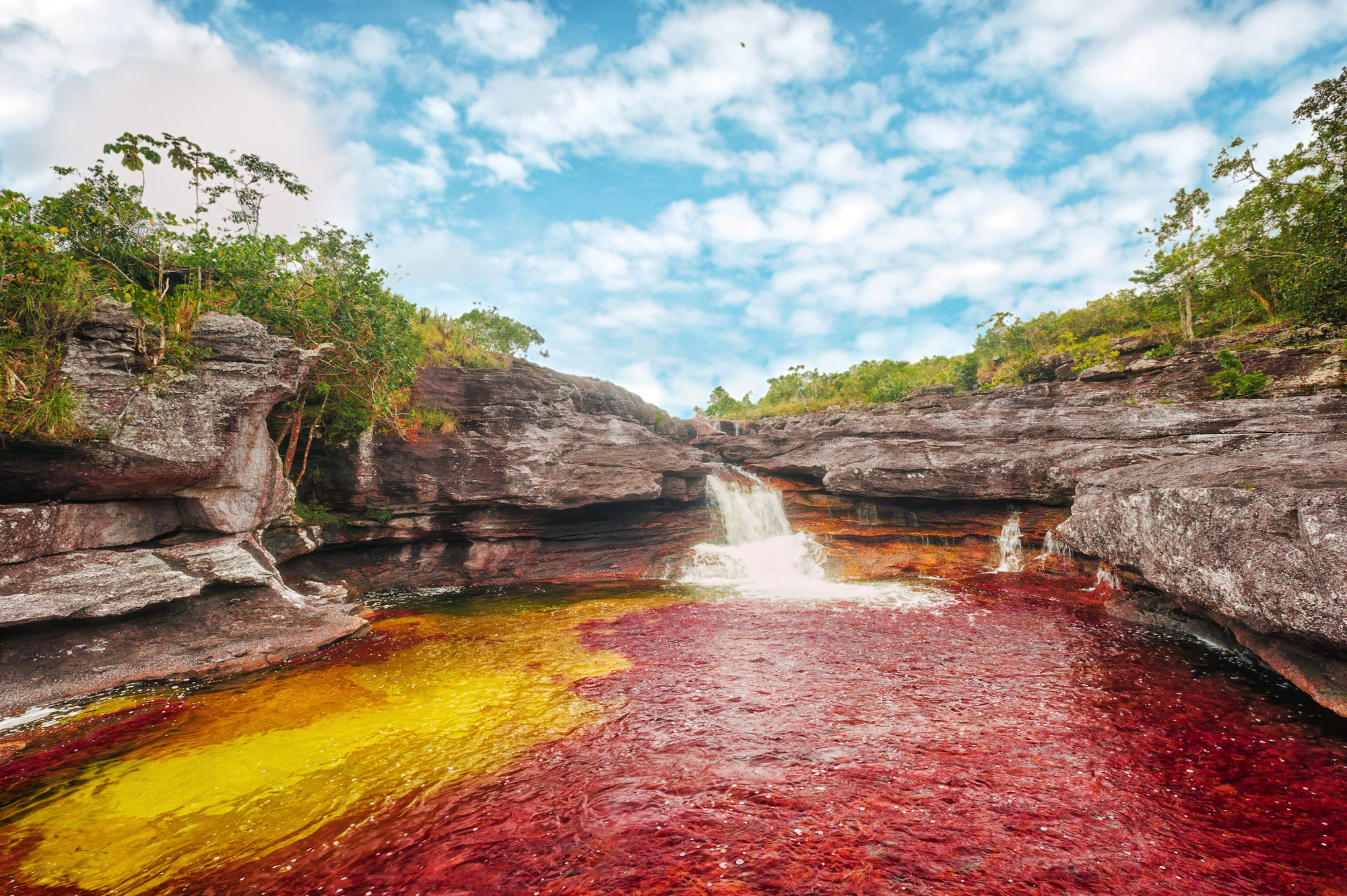
The Coastal Lowlands
lie along the Caribbean Sea and the Pacific Ocean. The Caribbean is an arm of the Atlantic Ocean.
The Caribbean Lowlands
have about 20 percent of Colombia’s people and about 12 percent of its industry. The busy Caribbean ports of Barranquilla, Cartagena, and Santa Marta handle most of Colombia’s foreign trade. Beyond these cities lie banana, cotton, and sugar cane plantations; cattle ranches; and many small farms. The narrow Guajira Peninsula forms the northernmost tip of Colombia. It is a dry area and has excellent coal deposits. The peninsula is the home of many Indigenous Guajiro people.
The Pacific Lowlands
consist mostly of swamps and dense forests. Heavy rains fall nearly every day. Few people live in the region.
The Andes Mountains
cover about a third of Colombia. They fan out from the southwestern corner of the country into three ranges—Cordillera Central, Cordillera Oriental, and Cordillera Occidental. The mountain ranges stretch northeast across western Colombia. They include the Nevado del Ruiz, an active volcano west of Bogotá. In 1985, Nevado del Ruiz erupted twice and caused over 23,000 deaths. An isolated range of the Andes, the Sierra Nevada de Santa Marta, rises from the Caribbean coast. It includes Colombia’s highest peak, Cristóbal Colón, which rises 18,947 feet (5,775 meters) above sea level.
About three-fourths of Colombia’s people live in the Andes. Rich mines, fertile farms, and large factories in valleys and basins of the Andes produce most of Colombia’s wealth. Coffee trees thrive on mountain slopes in areas of mild climate. Colombia’s two most important rivers separate the three ranges. The Magdalena River separates the Cordillera Central and the Cordillera Oriental. The Cauca River separates the Cordillera Central and the Cordillera Occidental. Farmers grow various crops in the rich soil of the river valleys.
The Eastern Plains
spread over nearly 60 percent of Colombia. Only about 2 percent of the people live in this hot, flat region. It is an important area because of its oil reserves. Tropical forests cover much of the south. In the north, farmers graze cattle on prairielike grassland called llanos. Several rivers cross the plains.
Climate
Colombia’s climate varies with elevation. The highest temperatures occur at the lowest altitudes—in the Coastal Lowlands and the Eastern Plains. Temperatures are much lower in the Andes Mountains. A zone of mild climate lies between 3,000 and 6,000 feet (900 and 1,800 meters). Above 6,000 feet (1,800 meters), the climate is cool the year around. Few people live in the cold mountain areas above 10,000 feet (3,000 meters).
Temperatures within a region vary little from season to season. For example, Bogotá, which lies about 8,660 feet (2,640 meters) above sea level in the Andes, has an average temperature of 58 °F (14 °C) in January and 57 °F (14 °C) in July. Each year, most of Colombia has one or two wet seasons with heavy daily rainfall, and one or two dry seasons with little or no rainfall.
Economy
Colombia is a developing country. The country’s economy has long depended on agriculture. Since the 1950’s, however, manufacturing has steadily grown in importance. Most businesses are privately owned. Until the 1990’s, the government was active in guiding the economy. Since then, the government has significantly decreased its intervention. Trade barriers also have been reduced.
Agriculture
accounts for less than 10 percent of Colombia’s total economy and employs about 15 percent of Colombia’s workers. The country’s varied climate and terrain enable farmers to grow a variety of products.
Colombia is one of the world’s leading coffee producers. Coffee is the country’s most important legal export crop by far. Colombia is also one of the world’s leading producers of sugar cane. Other major crops include bananas, cassava, corn, cotton, palm oil, potatoes, and rice. Cattle are raised for meat and milk. Chickens are raised for eggs and meat. Flowers are also an important source of income. Coca, the plant from which cocaine is made, is grown illegally. Colombia is the world’s largest producer of cocaine. 
Manufacturing
accounts for much of both Colombia’s economic output and its workers. Most factories are in or near Barranquilla, Bogotá, Bucaramanga, Cali, and Medellín. Colombia’s chief manufactured products include cement, chemicals, metal products, processed foods and beverages, and textiles and clothing.
Mining
is a rapidly growing industry in Colombia. Colombia is the largest coal producer in Latin America and one of the largest coal exporters in the world. The country exports much of the oil it produces to the United States and other countries. Other mined products include copper, emeralds, gold, iron ore, natural gas, nickel, platinum, and silver. Large underground salt deposits supply the raw material for Colombia’s thriving chemical industry.
Service industries
make up the largest sector of Colombia’s economy. They account for more than half of the country’s income and employ about two-thirds of Colombia’s workers. Finance and banking contribute more to Colombia’s economy than any other service industry. Many banks operate in Bogotá and Medellín. Tourists from Ecuador, Venezuela, the United States, and other countries help support Colombia’s hotels, restaurants, and shops.
Energy sources.
Hydroelectric plants supply much of the country’s electric power. Coal, gas, and oil produce most of the rest. Solar and wind power account for a small amount of electric power.
Trade.
Colombia imports more than it exports. The country’s chief imports include machinery, pharmaceuticals (medicinal drugs), refined petroleum, and transportation equipment. Petroleum is Colombia’s leading export. The country’s other exports include bananas, coal, coffee, flowers, gold, and textiles. The United States is Colombia’s leading trade partner. Colombia also trades with Brazil, China, Germany, Mexico, the Netherlands, and Panama.
The smuggling of illegal drugs, such as cocaine, from Colombia into the United States and other countries produces some income. However, Colombia plays a smaller role in the worldwide illegal drug trade than it once did. See also the Recent developments section of this article.
Transportation and communication.
The Magdalena River once served as Colombia’s chief transportation route. Today, most transportation is done on roads even though few roads are paved. Railroads are relatively unimportant in Colombia. Air travel is important because of the rugged terrain. Bogotá has one of the busiest international airports in Latin America. Barranquilla, Cali, and Medellín also have major international airports. Barranquilla, Buenaventura, Cartagena, Santa Marta, and Turbo have major seaports.
Radio and television stations operate under both private and state ownership. Dozens of daily newspapers are published in the country. Dailies with large circulations include El Espectador, El Nuevo Siglo, El Tiempo, and La República, all of which are published in Bogotá. However, many journalists have been threatened or killed by drug traffickers, guerrillas, paramilitary groups, and other people.
History
Early days.
Many Indigenous groups lived in what is now Colombia long before the first Europeans arrived. They included settled farming communities and nomadic hunting and fishing groups. The Chibcha, an advanced civilization in the Andes, traded emeralds and salt for gold and cotton with Indigenous people along the coast.
By 1500, Spanish explorers had sailed along Colombia’s Caribbean coast. The first permanent Spanish settlement in South America was founded at Santa Marta in 1525. A Spanish lawyer, Gonzalo Jiménez de Quesada, led an expedition into the Andes from 1536 to 1538 and conquered the Chibcha. In 1538, Jiménez de Quesada founded Santa Fe de Bogotá, now the city of Bogotá. He called the surrounding area the New Kingdom of Granada because it reminded him of the region in Spain known as Granada.
Spanish rule
gradually spread over the New Kingdom of Granada as Spanish colonists founded more and more towns. The colony lacked the mineral wealth of Mexico and Peru. But it produced emeralds, platinum, and some gold. Spanish settlers in the Andes forced the Indigenous people to work in the mines and on large estates that raised cattle and grain. Many Indigenous people died of mistreatment or of diseases brought by the Spaniards. Some of them intermarried with Spaniards, producing the beginning of a mestizo population. Along the Caribbean coast, the Spaniards brought Africans to the area and enslaved them on sugar cane and cacao plantations. On the Pacific coast, enslaved Africans were forced to work in the production of gold.
Most settlements in the New Kingdom of Granada were isolated by the rugged terrain, which made the colony difficult to unify and to govern. In 1564, the Spanish government appointed a president to govern the colony. In the early 1700’s, Spain combined the colony with neighboring territories into one large colony called the Viceroyalty of New Granada. The viceroyalty consisted of what are now Colombia, Venezuela, Ecuador, and Panama. Bogotá was the capital.
Independence.
Although New Granada had some able presidents, many colonists disliked Spanish rule. In 1780 and 1781, many people violently protested against new taxes. Spain crushed the revolt. But a movement for more autonomy (self-government) had begun.
Bogotá established an independent government on July 20, 1810, a date Colombians now recognize as their date of independence. Most of the provinces of the viceroyalty set up independent governments that same year. The French army occupied Spain at that time, and Spain’s South American colonies took advantage of the mother country’s weakness to declare their freedom. Spain sent troops to South America after the defeat of France in 1814. Bitter fighting followed.
In 1819, the Venezuelan general Simón Bolívar defeated Spain in the Battle of Boyacá, north of Bogotá. Bolívar then became the first president of Gran Colombia, a republic made up of the territory of the former viceroyalty. The name Colombia was chosen in honor of Christopher Columbus. Gran Colombia lasted only a short time. By 1830, Venezuela and Ecuador had broken away and become separate nations.
Political disorder
troubled Colombia from its start as a separate country. Conflicts arose over how strong the central government should be and how much influence the Roman Catholic Church should have on the government. These conflicts split the country into two groups. One group supported a strong central government and a powerful role for the church. It later became the Conservative Party. The other group favored a weak central government and strong regional governments. This group, which became the Liberal Party, also wanted to limit the role of the church.
Disputes between Colombia’s Liberal and Conservative parties often erupted into violence and civil war. The country had eight constitutions between 1821 and 1886, partly because each administration wanted to write a new constitution after taking office. The Constitution of 1853 abolished slavery. The Constitution of 1886, which established the Republic of Colombia, represented a victory for the Conservatives. It provided for a strong central government. But it did not prevent a fierce civil war, called the War of the Thousand Days, which was fought from 1899 to 1902.
The early to middle 1900’s.
Colombia lost Panama in 1903. That year, the Colombian Senate refused to approve a treaty that allowed the United States to build a canal across Panama. Panama then revolted against Colombia with help from the United States and quickly agreed to the canal project. In 1922, the United States paid Colombia $25 million for the loss of Panama. During World War II (1939-1945), Colombia helped the United States keep the Panama Canal open.
Continuing disputes between Colombia’s two major political parties reached a climax in 1948. That year, a popular Liberal Party leader, Jorge Eliecer Gaitan, was assassinated in Bogotá. Riots followed that left the center of Bogotá in ruins and many people dead. The fighting soon spread to the countryside, where warfare and banditry continued until the mid-1960’s. Colombians call this period La Violencia (The Violence). About 200,000 Colombians were killed during La Violencia.
By 1957, conditions in Colombia had become so unbearable that the Liberal and Conservative parties agreed to form a coalition (joint) government. Between 1958 and 1974, they shared all political offices, and the leaders of each party alternated as the nation’s president every four years. The coalition, known as the National Front, restored the people’s confidence in their government and improved the economy. However, this arrangement undermined democracy, because it excluded other political parties from governing.
Civil war.
In the mid-1960’s, left-wing guerrilla groups began fighting against the government. The two largest groups were the Revolutionary Armed Forces of Colombia (FARC) and the National Liberation Army (ELN). Each group supported establishing its own version of Communist government through armed revolution.
In the 1970’s, several criminal groups in Colombia began to make huge profits from producing and selling illegal drugs, especially cocaine. In the 1980’s and early 1990’s, the drug trade was controlled by cartels—that is, associations formed by suppliers to control the market for their product. The largest cartels were based in Medellín and Cali. Guerrilla groups also benefited from the drug trade. They took money from producers of coca, the plant from which cocaine is made. In return, they protected coca producers from the government.
In the 1980’s, the Colombian and U.S. governments began a joint effort to stop the drug trade. Colombia extradited (handed over) several drug traffickers to the United States for trial. In response, the cartels mounted a campaign of assassinations, bombings, and other terrorist acts. Right-wing paramilitary groups allied with the cartels carried out many of the killings. The cartels also made payoffs to the FARC and other left-wing rebel groups in return for their help in guarding drug fields and traffickers.
In the mid-1990’s, Colombian and U.S. law enforcement officials arrested or killed several cartel leaders, and the Medellín and Cali cartels were dismantled. Smaller organizations then took over the drug trade. 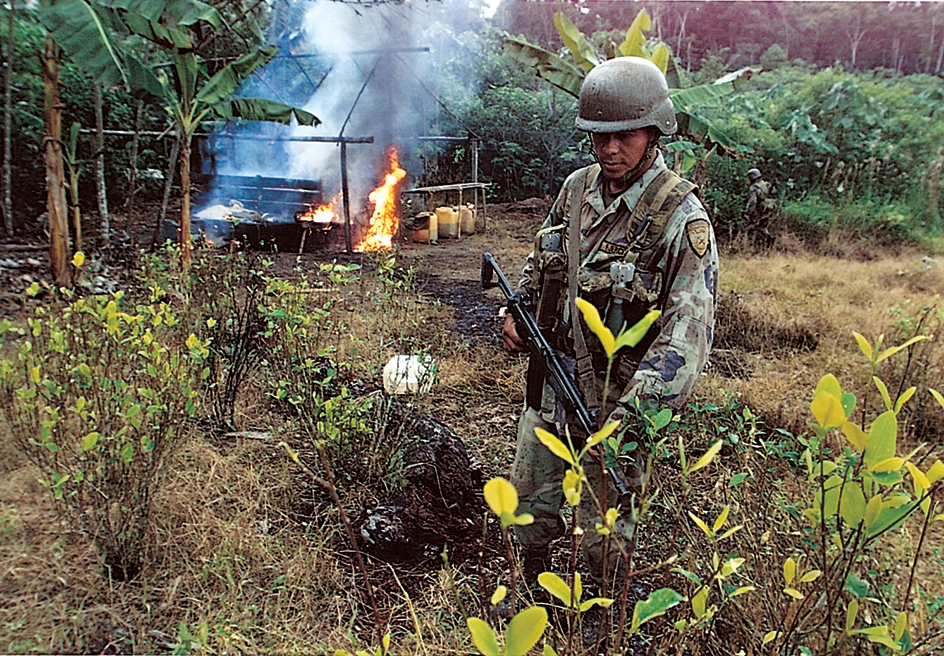
Negotiations between the government and several guerrilla groups in the 1980’s and early 1990’s resulted in peace accords with the Popular Liberation Army (EPL) and April 19 Movement (M-19). Many members of these groups disarmed, and some entered politics. The peace process led to the adoption of a new constitution in 1991. Government attempts to negotiate peace with the FARC and ELN in the 1990’s and first decade of the 2000’s were unsuccessful.
Several small right-wing paramilitary groups banded together during the 1990’s to form the United Self-Defense Forces of Colombia (AUC). The aim of the AUC was to fight left-wing guerrillas. The paramilitaries obtained a large amount of their funds from drug trafficking. They committed many kidnappings, murders, and other crimes against both guerrilla soldiers and civilians. In 2004, the Colombian government, led by President Álvaro Uribe, began disarmament talks with AUC leaders. By 2006, more than 20,000 AUC fighters had disarmed and the group had largely disbanded.
Recent developments.
Juan Manuel Santos of the centrist Social Party of National Unity was elected president in 2010, and again in 2014. In 2012, representatives of the Colombian government and the FARC formally began new peace negotiations. In 2016, the government and the FARC agreed upon terms for peace, and Colombia’s Congress quickly ratified (formally approved) the accord.
The disarmed FARC guerrillas formed a political party, the Revolutionary Alternative Common Force, also abbreviated as FARC. As part of the peace deal, several FARC party members became members of Congress. However, some FARC guerrillas refused to disarm or took up arms again after the peace talks. In 2017, Santos’s government also entered into peace negotiations with the ELN, but the talks faltered repeatedly in the following years.
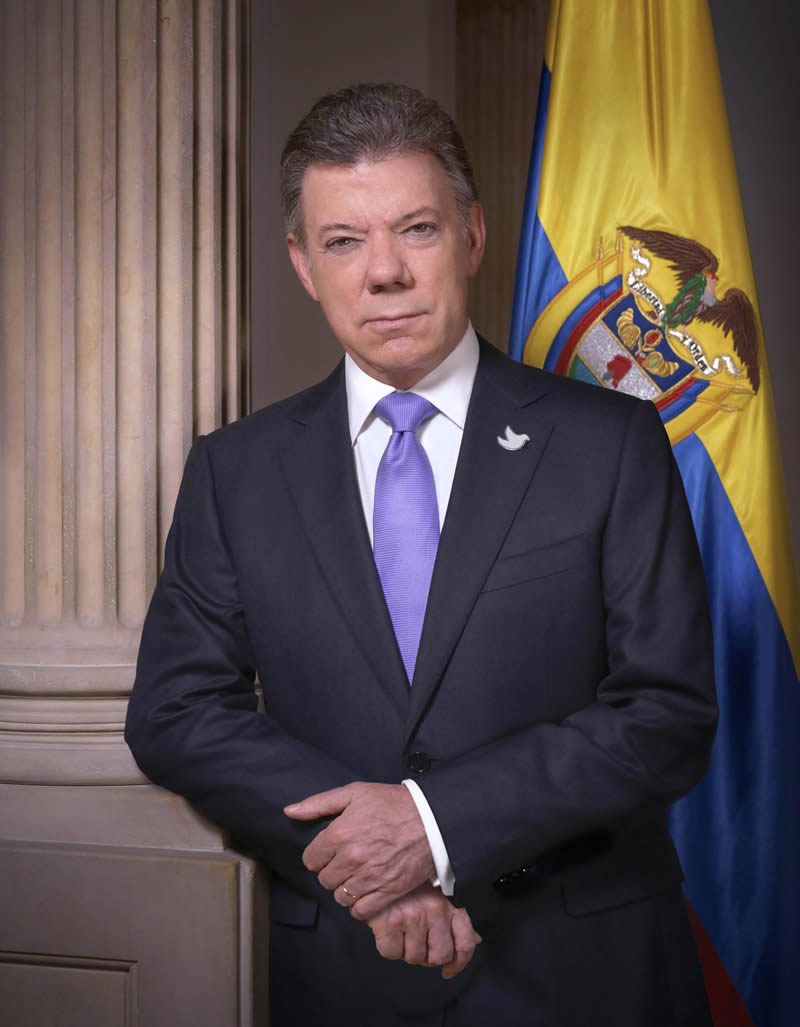
Also in 2017, heavy rains caused a mudslide that killed more than 250 people in southern Colombia. The mudslide wiped out parts of the city of Mocoa, near Colombia’s border with Ecuador. In 2018, voters elected Iván Duque Márquez of the conservative Democratic Center party as Colombia’s new president.
The COVID-19 pandemic (global outbreak of disease) that began in 2020 greatly impacted Colombia’s public health. COVID-19 is a respiratory disease caused by a coronavirus. During much of the pandemic, Colombia ranked among the nations with the most confirmed cumulative infections and deaths from COVID-19. As of early 2023, there had been more than 6 1/4 million confirmed cases of the coronavirus in Colombia, and more than 140,000 confirmed deaths from COVID-19. As in other countries, the outbreak also strained the economy.
In early 2021, proposed tax reforms to raise government revenue set off sometimes violent protests across the country. The government withdrew the reforms, but protests continued, fueled by anger about inequality, poverty, police use of force, and other issues. Dozens of people were killed in the protests, and many more were injured. In addition, many people were detained by the police.
Gustavo Petro, a former left-wing rebel and long-time legislator, was elected president of Colombia in 2022. He was the first left-wing candidate ever to be elected president. His running mate, Francia Márquez, became Colombia’s first Black vice president.
